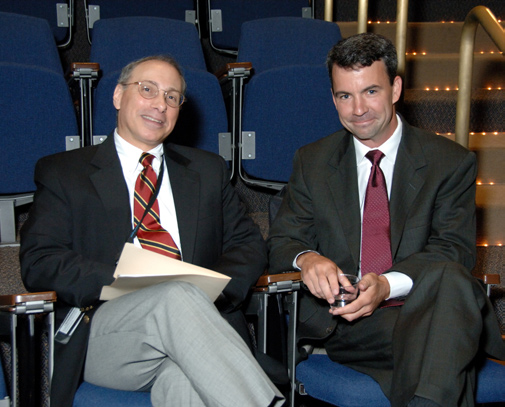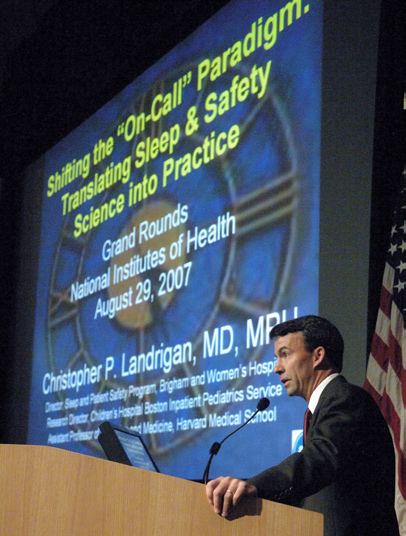| |
 |
|
|
|
|
| |
Dr. Christopher Landrigan suggests physicians work fewer consecutive hours to improve patient safety. |
|
Wake-Up Call
Such questions early in his career led him to become one of the foremost experts on sleep and safety research, a topic
given short shrift by the medical community until the last decade or so.
An NIH grantee via the Agency for Healthcare Research and Quality, Landrigan
was on campus recently to push for dramatic reform of physician schedules in his lecture, “Shifting the On-Call Paradigm: Translating Sleep & Safety Science into Practice.”
In addition to directing
the Pediatric Hospitalist
Fellowship Program at Children’s Hospital Boston, Landrigan is an associate at Brigham and Women’s Hospital, where he directs the Sleep and Patient Safety Program.
Over the course of his investigations of fatigue and performance, he discovered his personal experiences with sleep deprivation were shared by other doctors and could be documented.
“There is a large amount of data out there now that suggests people have different susceptibility
to sleep deprivation and to elements
of adverse schedules in general,” he said, “but I in particular was someone who suffered from a phenomenon known as sleep inertia.” Difficulty waking up, or problems performing immediately upon awakening define sleep inertia, but many other disorders
due to lack of rest or improper sleep exist, Landrigan explained. And all could easily
lead to mistakes on the job.
Doctors Are Human
“We now know that physicians-in-training working traditional schedules with recurrent 24- to 30-hour shifts make 36 percent more serious medical errors—and five times as many serious diagnostic errors—as those whose scheduled work is limited to 16 consecutive hours,” Landrigan said. “We also know that they have a 60 percent increased odds of suffering a needle-stick injury when working these long shifts, and are twice as likely to crash their cars when driving home. Those working five 24-hour shifts in a month report making four times as many fatigue-related medical errors that lead to a patient’s death.”
Landrigan said four major factors determine alertness and performance related to sleep deprivation:
- biological time of day (circadian rhythm)
- consecutive waking hours (the number of hours in a row you have been awake)
- nightly sleep duration (your sleep history over the past days or weeks)
- sleep inertia.
 |
| Dr. Robert Lembo (l), executive director of graduate medical education in the Office of Intramural Research, chats before Rounds with guest lecturer Landrigan, a pediatrician
who also directs the Sleep and Safety Program at Brigham and Women’s Hospital. |
Research has shown consistently, he said, that reaction time, for instance, becomes severely impaired with fatigue. “Regardless of whether
it’s 3 in the afternoon or 3 in the morning,” Landrigan said, describing data from a National
Transportation Safety Board study of truckers,
“if you’ve been up for 24 consecutive hours, you’re going to do worse than if you’ve been up for 3 hours.”
In 2000, the Institute of Medicine published a report, To Err Is Human: Building a Safer Health System, which drew attention to the problem of mistakes in medical care. “More people die in a given year as a result of medical errors than from motor vehicle accidents, breast cancer or AIDS,” IOM said then. Deaths due to medical mistakes ranked 8th among all causes of death that year in the U.S., according to estimates. Fatigue was a likely contributor: Medical residents
typically worked 100-hour weeks. Some did shifts of 36 hours straight. Like anyone else, it seemed, physicians need adequate rest to do their job well, Landrigan noted.
In an effort to improve patient safety, the Accreditation Council for Graduate Medical Education (ACGME) in 2003 mandated new rules for all residency programs. The council limited work hours to 80 per week and on-call continuous duty to 24-30 hours in a row. Landrigan
and colleagues argued that ACGME’s rules did not go far enough: 24-hour shifts should be eliminated altogether.
Citing a 1997 study published in Nature, Landrigan
said that after being awake about 17-19 hours, a person’s performance level drops to roughly the same as someone with a blood-alcohol level of .05. By hour 24, you perform as well as a person with a .10 blood-alcohol level, “which is beyond the legal level in every state in this country,” he said.
 |
| Citing a 1997 study in Nature, Landrigan said that after being awake about 17-19 hours straight, a person’s performance level drops to roughly the same as someone with a blood-alcohol level of .05. |
The Young and the Restless
Pilots get it. Truckers get it. Shouldn’t doctors—
of all people—get it? It is more sleep. More rest between work shifts. More downtime
to regroup. To a lay person, the benefits of a well-rested, fresh-faced decision maker
seem obvious, particularly when the decisions
being made are about someone’s health. Many in the medical community, however, have resisted change, Landrigan said. “Residents
used to be just that,” he explained in a later interview, pointing out the history of the term. “We’ve been training generations of doctors
this way for more than 100 years. However,
with today’s acuity of care and the advances
in medicine we have made, patients require many more interventions at night and residents
are far busier at night than they used to be. Most of the time, residents get fewer than 3 hours of sleep while working in the hospital for as many as 30 hours in a row. This leads to profound performance impairment.”
Those opposed to cutting physician hours say other factors should be considered: For example,
shorter shifts could result in each patient being treated by a “revolving door” of doctors. Health care systems must weigh the risks of fatigue-related mistakes against the benefits of continuity of care. In addition, traditionalists
argue, ultra-long shifts battle-test interns for the job of a doctor as no other training does. Also, hospitals would have to hire more doctors to cover gaps created by the new work schedules.
What economic impact would that have on health care’s bottom line? Critics of shorter
hours say more research is needed before we overturn a training tradition that has worked for more than a century.
This Just In
About a week after Landrigan’s Grand Rounds lecture, the Journal of the American
Medical Association released results of two studies on the ACGME rules. The research, which included more than 300,000 VA patients and over 8.5 million Medicare patients in hospitals around the country, found that the ACGME shift limitations did not cut patient death rates for Medicare patients and were associated
with only modest improvements in one subgroup of VA patients. The results seemed to suggest that a shorter shift length had no impact on patient well-being. Landrigan, however, put the data in context.
“First of all,” he explained, “the ACGME rules continue to allow shifts of up to 30 hours in a row, a duration well beyond that which the evidence demonstrates to be safe. In addition, prior research has found that compliance with the ACGME
duty-hours standards is extremely poor. Therefore it is not surprising that implementation of the standards has not led to measurable improvements in care in most settings.”
Landrigan said it’s time to stop just studying the problem. There is already an effective way to reduce fatigue-related errors and thereby improve patient safety and cut down on such work-related injuries as needle sticks and scalpel stabs as well.
“We have a tremendous amount of evidence demonstrating that it’s dangerous for doctors to work 24-hour shifts,” he concluded, noting that Australia and Europe have limits in place. “As a nation, we need to agree on evidence-based rules and enforce them. The Sleep Research Society and the Committee for Interns and Residents have called for maximum shift limits in the range of 16-18 consecutive hours. These recommendations are evidence-based and appropriate.” 